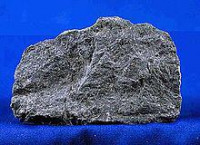|

Closeup of the basalt flow.

The lava flow is marked by columnar jointing toward the top of the cliff.

Basalt (/bəˈsɔːlt/, /ˈbæsɒlt/, /ˈbæsɔːlt/, or /ˈbeɪsɔːlt/)[2][3] is a common extrusive igneous (volcanic) rock formed from the rapid cooling of basaltic lava exposed at or very near the surface of a planet or moon. By definition, basalt is an aphanitic igneous rock with less than 20% quartz and less than 10% feldspathoid by volume, and where at least 65% of the feldspar is in the form of plagioclase. (In comparison, granite has more than 20% quartz by volume.) Basalt is usually grey to black in colour, but rapidly weathers to brown or rust-red due to oxidation of its mafic (iron-rich) minerals into rust. It almost always has a fine-grained mineral texture due to the molten rock cooling too quickly for large mineral crystals to grow, although it can sometimes be porphyritic, containing the larger crystals formed prior to the extrusion that brought the lava to the surface, embedded in a finer-grained matrix. Basalt with a vesicular or frothy texture is called scoria, and forms when dissolved gases are forced out of solution and form vesicles as the lava decompresses as it reaches the surface.






 Please share your ideas with us.
Please share your ideas with us.